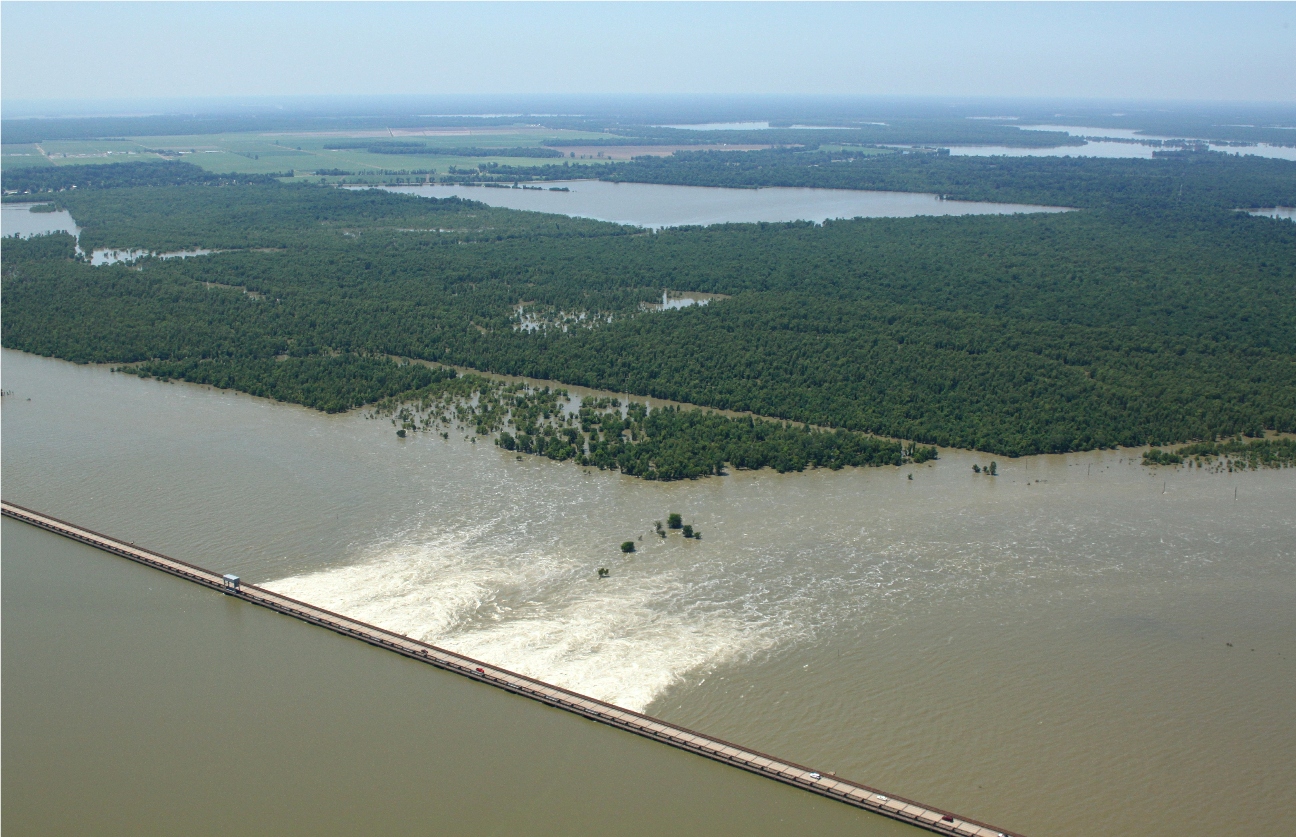The U.S. Army Corps of Engineers closely monitors river levels year-round to ensure safe navigation and safety of the public. An unusually wet spring and snowy winter across the Mississippi River drainage basin in early 2011 brought an unprecedented amount of water into the river via its tributaries and direct drainage and runoff.
The New Orleans District initiated Phase 1 of its formal “flood fight” on March 15, 2011, when the Mississippi River stage reached 11 feet and rising at the Carrollton gauge and the Atchafalaya River stage reached 5 feet and rising at the Morgan City gauge. Phase 1 flood fight involved weekly inspections of the river levees within the New Orleans District’s area of responsibility. Additionally, the Corps began initial preparations of the flood control structures at Bonnet Carré, Morganza and Old River for potential flood control operations.
The New Orleans District initiated Phase 2 of the flood fight on May 5, 2011. Phase 2, which is triggered when the Mississippi River stage reaches 15 feet and rising at the Carrollton gauge and the Atchafalaya River stage reaches 6 feet and rising at the Morgan City gauge, includes daily inspections of all Mississippi River levees, affected Atchafalaya River levees and flood risk management structures within the Mississippi River & Tributaries (MR&T) system.
The decision to operate or “open” the Bonnet Carre’ Spillway, Morganza Floodway and other flood control structures is the responsibility of the Mississippi River Commission (MRC) president who has broad jurisdiction over the entire MR&T project. The MRC president relies heavily on the recommendations of the local District Engineer who is responsible for the actual operation of these structures and floodways
With the volume of Mississippi River flows reaching 1.25 million cubic feet per second at New Orleans, Maj. Gen. Michael Walsh, MRC President and Commander of the Mississippi Valley Division, ordered a partial opening of the Bonnet Carre’ Spillway on May 9, 2011. The Bonnet Carre’ Spillway is located about 33 river miles above New Orleans on the east bank of St. Charles Parish and diverts a portion of the river's floodwaters via Lake Pontchartrain into the Gulf of Mexico, thus allowing high water to bypass New Orleans and other downstream river communities. At peak operation, 330 of the 350 total bays were open and passed 316,000 cubic feet of water per second. The New Orleans District began closing bays on June 11, 2011, and completed that operation on June 20. For more information on the Bonnet Carre Spillway, click here.
With the volume of Mississippi River flows reaching 1.5 million cubic feet per second and rising at Red River Landing and in close coordination with local, state and national partners and stakeholders, Maj. Gen. Walsh ordered a partial opening of the Morganza Floodway on May 14, 2011. The Morganza Floodway is located 186 river miles above New Orleans on the west bank of Pointe Coupee Parish and is designed to divert a portion of the river's floodwaters southward guided by the East Atchafalaya River levee before joining the Atchafalaya River Basin Floodway near Krotz Springs, La. At peak operation, 17 of the 125 total bays were open and passed 182,000 cubic feet of water per second. The New Orleans District began closing bays on May 24, 2011, and completed that operation on July 7. For more information on the Morganza Floodway, click here.

In May 2011, the Corps partially opened the Morganza Floodway for only the second time ever. At peak operation, 17 of the 125 total bays were open and passed 182,000 cubic feet of water per second.
The river crested at 17 feet in New Orleans on May 14. It crested at 63.09 feet at Red River Landing on May 21 and then 10.35 feet in Morgan City on May 30, 2011. The Corps distributed approximately 1.2 million small sandbags, 10,000 jumbo (3000 lb) sandbags, and 45,000 linear feet of HESCO Baskets to support local flood fighting efforts; participated in at least 20 public meetings / town halls; and hosted daily stakeholder teleconferences to foster an open dialogue with partners and stakeholders and maintain a coordinated response. The Corps also communicated to the public by participating in approximately one thousand media engagements and through regular updates on social media sites such as Facebook, Twitter, and Flickr.
In close collaboration with approximately 10-15 federal and state partners and non-governmental organizations, the Corps continues to assess the water quality of the Mississippi and Atchafalaya Rivers, Lake Pontchartrain Basin and Mississippi Sound in response to the 2011 opening of the Bonnet Carre' Spillway and the Morganza Floodway. The Corps began weekly conference calls in early May 2011 and continues to exchange information and field experiences with the collaborating organizations. To access the monitoring map developed in response to opening the Bonnet Carre' Spillway and Morganza Floodway, the Corps and the U.S. Geological Survey created a monitoring website available at: http://deltas.usgs.gov/spillway/BonnetCarre2011.aspx.
This year alone, the MR&T system prevented approximately $100 billion in damages. Since 1928, the MR&T has prevented more than $470 billion in damages at an investment of approximately $14 billion, for a 34-1 return on investment for the U.S.
